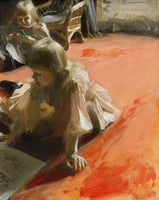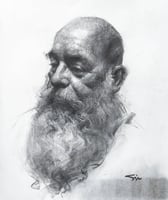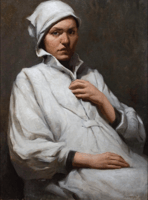The Zorn palette: what it is and how it can be used The zorn palette se refers to a color palette...
Composition
THE COMPOSITION
Composition involves organizing visuals with the guidance of principles of art to promote the artist's statement.
VISUAL ELEMENTS
The visual elements are the building blocks in the painting. Line, shape, color, texture, space and depth.
PRINCIPLES OF ART
The visual elements are organized taking into account a series of principles known as principles of art.
Rhythm, balance, emphasis, gradation, harmony, variety, movement, and proportion
RHYTHM
We must have repetition to have rhythm. Visually, rhythm is created by repeating elements. This could be a regular or irregular pattern of repetitive shapes or it could be a repetition of a specific theme. Either way, the repeating elements produce a rhythm.
MOVEMENT
Movement can refer to the illusion of actual movement in a drawing or painting; Or it can refer to the movement that the spectator's eye takes when looking at the work.
MOVEMENT THROUGH DIAGONAL
You can create dynamic compositions by incorporating diagonals into your work. These diagonals can be created with real lines and shapes or implicit lines. They can also be used to help guide the viewer's eye through the work.
BALANCE
Balance refers to the general distribution of visual weight in a composition. Each object that we include in a work carries with it a visual weight. When we add an element to one side of our composition, we would like to have to add another or several elements to balance the visual weight on the other side.
WHICH IMAGE LOOKS MORE BALANCED?
Many times, we will have elements that extend beyond the limits of the image plane. If the edges of these elements are positioned so that they are close to the edges of the image plane, this will create additional visual weight and perhaps unwanted attention.
If we position subjects in our works so that their edges end a little further from the edges of the image plane or extend well beyond the limits of the image plane, then this visual weight is minimized.
HARMONY
Harmony is about a feeling of "oneness." We can achieve unity through brushstrokes, colors, artistic style ...
If the individual parts of the piece work together, then the art could be considered harmonious.
EMPHASIS
Emphasis is generally created in a work through some form of contrast.
Most of us are drawn to the woman on the scene, more specifically, to her face. Degas has drawn our attention to her using various methods. For starters, it is located in the center of the image plane. There is also a strong contrast of value around it. Observe how the man next to him is dressed in black, while he is dressed in white. There's even a dark shadow on the wall right next to his light face.
Then there are the convergence lines created by the boards and the trailing edge of the bench.
You will also notice that the woman's face has more detail compared to the other elements within the scene. This also helps attract the attention of the viewer.
VARIETY
Like emphasis, variety also deals with difference. Our drawings and paintings must include some variety.
The trick here is to balance both harmony and variety. If we take the variety too far, the work will probably not be harmonious. If we take harmony too far, work can be boring.
COMPOSITION TECHNIQUES
SIMPLIFICATION
You can simplify your composition:
- Using a limited palette (color range)
- Reducing the details of unimportant areas.
- Using a limited range of values
- Using larger brushes to simplify details.
- Erasing unnecessary themes.
Simplification is most effective when combined with specific complexity.
PROBABILITY RULE
The "rule of probabilities" suggests that an odd number of subjects in an image is more interesting than an even number. An even number of subjects produces symmetries in the image, which can appear too formal and unnatural.
RULE OF THIRDS
The rule of thirds is a technique used to ensure that the focal point of your painting is not directly in the center and that your painting is not too symmetrical. What it involves is cutting the scene into thirds in both directions. You will end up with nine sections. The goal is to place your focal point at one of the intersections and make sure that none of your sections are the same.
GEOMETRY AND SYMMETRY
Related to the rule of probabilities is the observation that triangles are an aesthetically pleasing implicit shape within an image. On an attractive face, the mouth and eyes fall into the corners of the equilateral triangle area.
POSITIVE AND NEGATIVE SPACE
The space that takes up important themes or design elements is considered positive space. The areas surrounding these places are considered negative space.
The positive and negative spaces work together to create the composition. A composition can be made up primarily of positive space, a uniform balance of the two, or mostly negative space.
CONTRAST
Contrast deals with difference. This could be a difference in value, color, texture, size, etc. When we include an area of strong contrast, it draws the viewer's attention to that location in the work and creates a focal point.
ISOLATION
When we isolate a subject or an element in a drawing or painting, this element naturally attracts attention and becomes a focal point.
PLACEMENT
If we place a subject near or exactly in the center of our image plane, then this subject becomes a focal point.
CONVERGENCE
Convergence refers to the act of guiding the viewer's eye within a work using visual cues. It can be lines, shapes, contrasting colors, etc. Each element we include can guide the viewer's gaze to the focal point.




